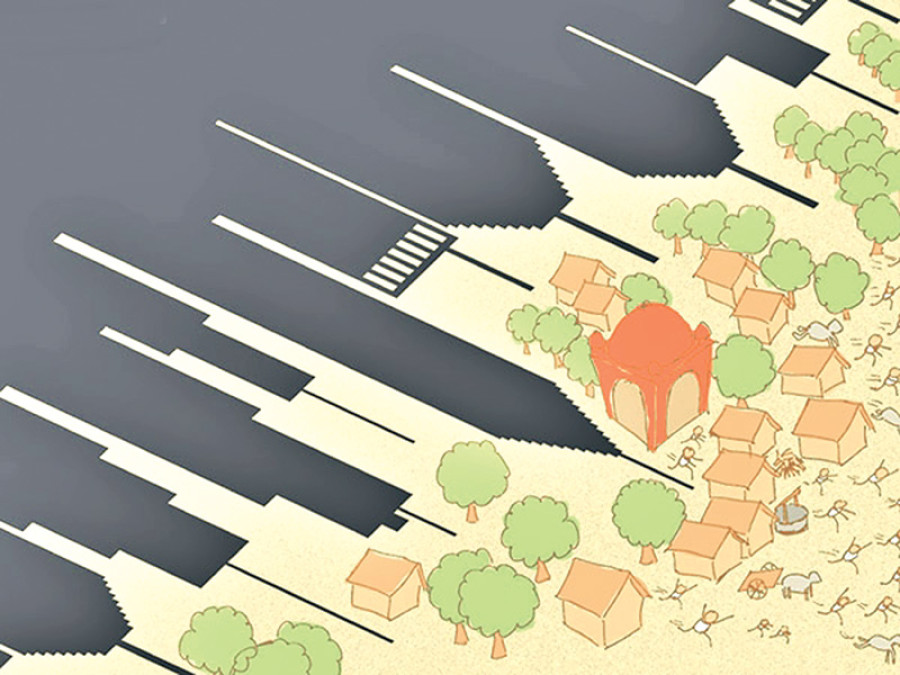Opinion
Elusive decentralisation
Instead of turning Kathmandu into a mega city, we should develop cities elsewhere
Prashanta Khanal
The government has recently announced that four satellite cities will be built in the Kathmandu Valley. The Japan International Cooperation Agency (JICA) has also proposed establishing several satellite cities in the Valley connected by an outer Ring Road and multi-lane highways. However, building such satellite cities inside the small Valley and very close to the metropolitan area is simply an absurd plan. This will have a multitude of repercussions on the Valley’s urban environment. First, the satellite city might only be reasonable if it is located considerably far from the metropolitan area. In fact, building satellite cities in the Valley will not solve the ongoing haphazard urban expansion as has been claimed, but it will rather aggravate urban sprawl.
Satellite cities are theoretically supposed to be self-reliant with compact urban development, but in reality, cross commuting is frequently driven by housing cost, employment and the economics of the city. The Valley will be further gridlocked with induced motor traffic and choked with air pollution from the increasing movement. The example of Gurgaon, which was developed as Delhi’s satellite city, should be a cautionary tale on how not to urbanise. Massive traffic jams on the multi-lane highways connecting the two cities are common.
Traditional settlements
The proposed satellite cities in Kathmandu will also destroy the only few fertile agricultural and green spaces left in the Valley. Much of the northern part of the Valley has already been filled with sprawling settlements putting pressure on groundwater recharge, availability of green spaces and connectivity. Traditional Newar settlements and their artistic heritage will be pushed to the verge of extinction with the expansion of the so-called modern smart satellite cities. Building new cities also involves huge cost for infrastructure and is very resource intensive. These new cities will require expensive road infrastructure, even more without a transit network plan.
There is a lot of talk about decentralised development to decelerate rapid urbanisation of the Kathmandu Valley, but the development priority of the government and planners is still very much Capital-centric. This will not only divert much needed resources to build infrastructure and services in other cities and towns of Nepal, but also further fuel migration and haphazard urbanisation in the Valley. Neither are such priorities aligned with green inclusive growth as envisioned by the country.
The government needs to invest in developing other cities in Nepal and improving connectivity with the Capital through e-rail or efficient transit network (not wide roads) instead of pouring money into expensive satellite cities and road expansion projects. The Kathmandu Valley requires policies and funding to develop a more compact mixed land-use and make the city more walkable, cyclable and transit-friendly.
The existing built-up areas and settlements in the Valley are very inefficient in space usage with often low-rise individual gated houses and more space apparently for cars than for people to live in. This is common even in land-pooled planned areas, which are simply plotted land with wide roads left almost entirely to an individual to build. The government should bring policies to encourage and invest in infill development in which existing inefficiently used land space and gated communities are turned into compact settlements with mid-rise buildings. If planned properly, this will check a potential housing crisis in the future and contribute to sustainable urban development. Urban core areas in the Kathmandu Valley need to be revitalised to make them liveable by regulating motor vehicle movement and conserving traditional mixed compact Newar settlements, open spaces and greenery.
Transit-oriented development, an approach to developing dense, compact, mixed-use and walkable land-use around a high quality transit system is absolutely necessary to discourage car-dependent urban living and urban sprawl and move towards a more sustainable city. The government should stop allowing housing and apartment development in areas not served by a high quality public transport system or at least where it is not planned. What the government needs to invest in now is developing an efficient affordable transit network, not new satellite cities or towns.
A separate political appointee
The Kathmandu Valley Development Authority (KVDA), which will be responsible for building the satellite cities, lacks resources (both human and financial). The authority is largely focused on simply expanding roads, and doesn’t have any strategic plan to implement integrated urban development in the Valley for which it was actually formed. And there is likely to be huge lapses in coordination between the authority and the several mayors of the Valley regarding integrated urban planning. The KVDA needs political support, adequate financial resources and skilled human resources with the right attitude and visionary leadership. The Kathmandu Valley also probably requires a separate political appointee such as a governor to coordinate integrated urban development.
More than transforming the Kathmandu Valley into a mega city, our vision should be developing other small cities and towns that are sustainable, resource-efficient and liveable. How about investing in urban infrastructure and services in Banepa city and connecting it to the metropolitan area with a good surface light rail?
Decentralised development, investment in connectivity, transit-oriented development and urban infill projects will be the best approaches to contain the rapid urbanisation in the Valley, and at the same time, support the country’s development needs and overall inclusive growth.
Khanal is an avid cycle user and works on issues of urban transportation, air quality management and sustainable cities




 18.12°C Kathmandu
18.12°C Kathmandu










%20(1).jpg&w=300&height=200)

